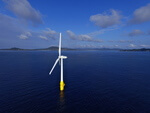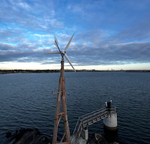UK initiative launched to advance technology for sustainable and recyclable wind turbine blades
The NCC has today launched an initiative to accelerate the development of technology, processes and materials that address the recyclability and future development of composite wind turbine blades.
Delivered in partnership with the Offshore Renewable Energy (ORE) Catapult and supported by The Crown Estate and RenewableUK, SusWIND is helping to drive the future sustainability of wind turbine technology. It brings together leading stakeholders in the composites industry and energy sector to solve the following sustainability challenges:
- RECYCLE: Demonstrating viable technologies for recycling the existing stock of wind turbine blades, many of which are reaching the end of their life, and then using the waste materials to develop secondary applications such as composite parts in electric vehicles, bridges and even in thermal insulation.
- SUSTAIN: Driving the use of more sustainable materials, such as bio-derived feedstock or thermoplastics in developing composites for turbine blades, rather than from unsustainable sources or with limited potential for economic recyclability.
- DESIGN: Developing innovative new approaches based on design for disassembly, utilising sustainable materials and with end-of-life strategies in mind, therefore future-proofing the next generation of wind turbine blades.
Wind energy is one of the fastest growing sources of renewable energy with predicted global capacity expected to reach approximately 5,000GW (1) for onshore and 1,400GW of offshore capacity by 2050 (2). The UK has the largest offshore wind capacity in the world (3,4) with over 14GW of total capacity. In 2019, 20% of the UK’s electricity supply was generated from wind power, which is enough to power more than 18 million homes and saves over 29 million tonnes of CO2 annually.
This continues to grow; the UK is on track to exceed 40GW in the pipeline by 2030 – that’s enough to power all homes across the country. This world-leading position for the UK will continue well into the future and drive our commitment to net zero by 2050.
Technology in turbine blade design and manufacture has advanced rapidly over the last 40 years. Today, approximately 2.5 million tonnes of composite materials are in use in the wind sector globally (5), and using composites has made wind turbine blades lighter, stronger, longer lasting and even larger, enabling the current generation of blades to exceed 100m in length. This drives the turbine efficiency up and the costs of energy production down. A typical wind turbine takes just six to nine months of operation to generate as much energy as it consumes in its entire lifecycle. It is also able to pay-back the carbon released in its lifecycle within a similar timeframe (6).
Although most of the existing components and materials used in wind farms are recoverable and recyclable, the blades are a bigger challenge and are one of the missing pieces that would enable the industry to achieve a truly zero waste outcome. Around 14,000 wind turbine blades are reaching the end of their usable life and facing either disposal in landfill or incineration. That’s almost 50,000 tonnes of industrial waste where the valuable composite material could be recovered and recycled to be used for many other applications.
Richard Oldfield, Chief Executive of the NCC, said: “Composites are a key enabler for the success of wind energy and the role that it plays in delivering a low carbon global economy. But it is apparent to engineers, economists and environmentalists alike that we need to find a more sustainable way forward. We must commit to transforming the current linear blade product lifecycle into an increasing circular process that forms part of a larger future market for low carbon, recycled composites materials. Investing now in the future of blade sustainability will help unlock the use of recycled composites for the next generation of sustainable transportation and infrastructure. We’re excited to work with key partners and the wind industry through this ambitious programme to deliver a more sustainable future.”
Dr Stephen Wyatt, Research and Innovation Director at ORE Catapult, said: “As we strive to achieve net zero, offshore wind capacity globally is set to grow rapidly to meet our low carbon energy needs. It’s therefore vital that we work to minimise the direct impact on our environment and look for new and innovative ways to recycle the existing fleet of wind turbines and their blades. We must also work at the same time to future-proof technology for the next generation through the use of composites or more environmentally friendly and sustainable materials. We are pleased to be working on SusWIND to solve this major industry technology challenge.”
Ambitious leasing rounds are planned for the UK by The Crown Estate which, together with the UK Government and the wind energy sector, has driven the UK’s offshore wind capacity from a standing start in 2000 to meeting 10% of the UK’s electricity demand by the end of 2020. However, sustainability and technology transcend borders and sectors. The outcomes of SusWIND are designed to support the global challenge for both onshore and offshore wind, reflecting the global footprint of many of the leading organisations in the industry.
Adrian Fox, Head of Offshore Assets at The Crown Estate, said: “As managers of the seabed around England, Wales and Northern Ireland, we’re working closely with government, industry and stakeholders to help enable the sustainable, coordinated growth of UK offshore wind. We’re delighted to support SusWIND, which offers an opportunity to help translate the important principles of circular economy, already being considered across our real estate portfolio, to further boost the environmental sustainability of wind turbines offshore.”
Luke Clark, Director of Strategic Communications at RenewableUK, added: “Sustainability is at the heart of what drives the renewables industry. We regularly see old turbines from the UK being given a second life through re-use in other countries and we’re starting to see reprocessing of turbine blades, for example in the manufacture of concrete. SusWIND is a welcome initiative to boost sustainability, recycling and reprocessing of turbines as the industry gears up to help deliver the UK’s net zero emissions target.”
Lisa Ekstrand, Senior Director and Head of Sustainability, at Vestas, said:
“We want to leave the Earth a better place than we found it. That is why our vision is to become a global leader in sustainable energy solutions and why we are to become sustainable in everything we do. We have committed ourselves to four sustainability objectives. One of these four is to produce zero-waste wind turbines by 2040 and addressing the specific challenge on recyclability of composite turbine blades is key to achieving this. We are excited to be a part of the SusWIND programme, and as founding members of the NCC we are confident that this initiative will drive technology forward to help solve this challenge that we all face.”
Jim Smith, Managing Director of SSE Renewables, said:
“Harnessing the abundant supplies of wind energy in and around the UK and Ireland is one of the most important contributions SSE Renewables can make in the race to net zero. The sustainable use of the world’s resources and reducing the impact of our activities on the natural environment is just as critical. That’s why SusWIND is so important to us – as well as improving the sustainability of wind turbine blades already in use, this national initiative will help deliver a next generation of blades that can be recycled at the end of their life. In doing so we can build a truly sustainable supply chain for the wind industry in every sense.”
SusWIND is being delivered as part of Sustainable Composites, which is looking at the whole lifecycle of composites to future-proof the aeroplanes, cars and turbines of tomorrow. Led by the NCC and CPI – two of the seven High Value Manufacturing Catapult centres – Sustainable Composites is a partnership between industry, academia and government that will harness the UK’s world-leading composites research and technology development capabilities to capitalise on this rapidly growing circa £2bn global market for end-of-life recycling.
The initiative will be delivered in three waves of activities to address the sustainability challenges for wind turbine blades:
- Wave 1 will stimulate the supply chain for blade recycling and how it leverages the broader supply chain for composites recycling demand with other sectors. Work packages including landscape mapping, exploitation routes for upscaling viable technologies and demonstrating the effective use of recycled materials in value-add products for other applications.
- Wave 2 will demonstrate options to reduce the environmental footprint of blade manufacture through the use of more sustainable and lower impact material feedstock, and through minimising or recycling waste streams.
- Wave 3 will develop robust guidelines to improve design for end-of-life, ensuring waste is minimised and that composite components can be disassembled for cost effective repaired,
re-used, remanufactured and recycled more efficiently and cost effectively.
The NCC is looking for more companies from the energy industry to get involved in this exciting programme to help to shape the direction of this work. Email suswind@nccuk.com to find out how you can join the consortium. Together we can harness the power of engineering creativity and technology innovation to create a more sustainable future for us all.
- Source:
- National Composites Centre (NCC)
- Author:
- Press Office
- Link:
- www.nccuk.com/...
- Keywords:
- NCC, recycling, turbine, blade, rotor blade, incineration, ORE Catapult, sistainability, design


























